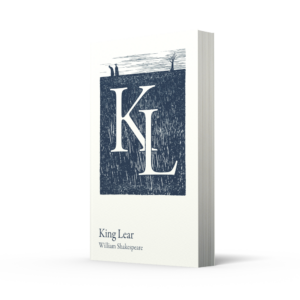Any teacher introducing King Lear in the classroom, whether for the first, or even the 20th time, can’t but help feel daunted by the sheer philosophical and emotional heft of Shakespeare’s most-studied tragedy. How do we convey the significance and complexity of its over-arching themes, such as power, loyalty and forgiveness, and yet do justice to the play’s more intense, personal moments? How can we help students connect with or even care about the descent and decline of an ancient British king? How do we link events in the wide, brutal, inhospitable landscape of Lear with the play’s smaller-scale (but no less significant) dramas of home, family and friends?
Here are some activities and discussion points designed to forge creative, positive connections with the text through character and language. King Lear may be a play that concludes with ‘general woe’ (5.3.l.324) but it can still be a vital, transformative text for those who study it.
-
Tragedy – pre- and post-reading task
As a pre-reading task, ask students to research the main ‘ingredients’ of a classical tragedy. Below are some key terms from Aristotle’s Poetics which they can define in their own words. Can they include illustrative examples from texts or films that they have studied or know already?
| Hamartia | Anagnorisis | Catharsis | Hubris | Peripeteia |
Now ask students to use what they have learned about tragedy and their own wider reading to plot the narrative arc of the typical tragic hero: where the x axis marks the changing fortune and power of the main character, and the y axis is time (N.B. this should be a bell curve). Now ask them to look again at the tragic ‘ingredients’ above and label where they might expect to find them on the bell graph.
As a post-reading task students can return to their original graph and see if their prediction matches King Lear. (Note that what is interesting about Lear as a tragic character is that we do not see his rise to power. The play opens at precisely the moment he abandons his regal authority).
The following activities will work best if students have an overview of the play’s plot and characters, but they can be integrated at any point into teaching of the text.
-
More sinn’d against than sinning: characters on trial
In Act 3 Scene 6 Lear conducts a mock trial of his ‘hard-hearted’ disloyal daughters who have abandoned him to the elements. Using hot seating, students can conduct their own mock trial of the main characters in the play. Allocate parts as follows:
- main character(s)
- prosecutor
- defender
- judge
- members of the jury
Decide for each character whether they are ‘more sinn’d against than sinning’: innocent or guilty. For example, Edmund’s defence may question him about his relationship with his father Gloucester and argue, ultimately, that his illegitimate and inferior status within the family drove his desire for revenge. Edgar, on the other hand, could be asked why he fled and assumed the Poor Tom disguise rather than stand up to his (false) accusers. Hopefully this task will bring out some of the moral ambiguity which is central to the play’s impact.
-
Tracking Language: Lear ABC
Lear’s transformation in the play can be plotted through his changing use of language. Put the following speeches on a sheet of paper and label them A, B, C. Do not include information about the act or scene where they occur in the play.
A ‘Rumble thy bellyful! Spit, fire! spout, rain!’ to ‘So old and white as this. O! O! ’tis foul!’ [Act 3 Scene 2]
B ‘Pray, do not mock me’ to ‘To be my child Cordelia’. [Act 4 Scene 7]
C ‘Hear, Nature, hear, dear goddess, hear!’ to ‘To have a thankless child. Away, away!’ [Act 1 Scene 4]
Now ask students – either individually or in groups – to complete the following task:
Put the three speeches in the order in which they appear in the play. What is the context for each speech? How would each be delivered in performance? Tone? Volume?
Annotate each speech for the following:
Rhythm – are the lines even? Do they follow or break with iambic pentameter?
Emphasis – what words appear to be stressed and why?
Imagery, semantic fields, patterns in words?
Sound patterns which create a dramatic effect?
Now open a discussion about how we relate these differences in language use to changes in Lear’s behaviour, attitude, and character as the play develops.
-
King Lear: in performance
King Lear is now the most frequently performed of Shakespeare’s plays. There are not only numerous stage versions of the text, but also many film versions which provide useful and varied interpretations. Ask students to discuss what would be the impact of the following directorial decisions in a new staging of the play:
- Casting Lear as a woman?
- Casting Goneril, Regan, and Cordelia as men?
- Relocating the play to a 21st-century setting?
- Non-white or very racially diverse casting of some or all of the main characters?
- Casting Lear as a younger, rather than much older, man?
- Radically editing the play – removing the storm scenes perhaps – or cutting the sub-plot with Gloucester entirely?
-
Discussion points
Many exam questions on the text ask students to engage with a critical comment and, using evidence from the text, either support or challenge this critical view. The following statements can be used as prompts for classroom discussion and/or essay planning:
- Lear ruled and built a hostile, brutal kingdom in which there was no pity for the vulnerable: his downfall and destruction were therefore well-deserved.
- The only decent, loyal characters in King Lear are the servants.
- Women are not monsters in King Lear: others make them so.
- Edmund not Edgar would be the more fitting successor to Lear’s throne.
- King Lear is a play about bad fathers, not bad children.
- In King Lear Shakespeare stops short of challenging power and authority: at the end of the play the poor are still poor and the rich are still rulers.
- ‘The law is mine not thine’: women are punished in King Lear for daring to take power from men.
- By the end of the play, we no longer fear Lear, we pity him.
By Maria Cairney, writer and sixth form English teacher. Maria has written introductions to Collins Classroom Classics editions of Dracula, Hard Times, The War of the Worlds, King Lear, Much Ado About Nothing, Great Expectations and Wuthering Heights.
Collins Classroom Classics are KS3, GCSE and A-level set texts and plays that are perfectly pitched for students.
View the full range, including William Shakespeare’s King Lear for A-level students.
Read our teaching tips for other Collins Classroom Classics set texts:
- Considering Dracula and the supernatural: teaching tips
- Exploring childhood in Hard Times
- Tips for digging deeper into George Orwell’s Animal Farm
- Top tips for exploring Hamlet’s key themes
- Considering Macbeth’s Soliloquies




